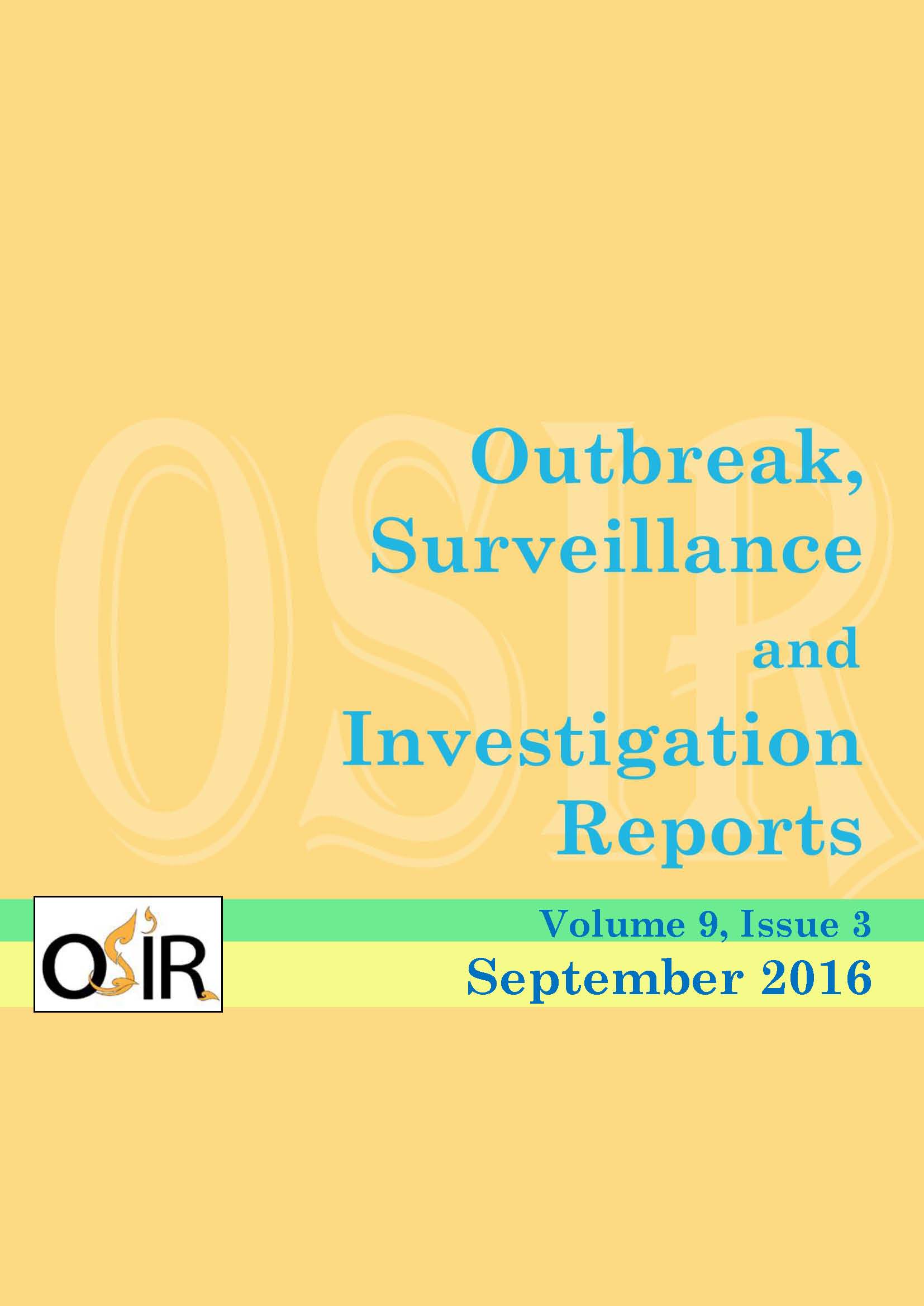Malaria Surveillance at Thai-Myanmar Border, Mae Sot District, Tak Province, Thailand, July 2013
DOI:
https://doi.org/10.59096/osir.v9i3.263212Keywords:
malaria, surveillance, cross-borderAbstract
Malaria epidemic along Thai-Myanmar border is still an ongoing occurrence. We explored malaria surveillance systems in Mae Sot District in order to improve the detection and response efforts in the region. The main objective was to study effectiveness of the malaria surveillance systems at Thai-Myanmar border. Data were collected by reviewing medical records, interviewing personnel at operation levels and observing the surveillance sites. The reporting system under Bureau of Epidemiology (BOE) was hospital-based, with 76% coverage, 100% positive predictive value and 100% timeliness. It was acceptable and stable, yet less flexible. The reporting system of Bureau of Vector Borne Disease (BVBD), existed from the village level, was used to obtain information for malaria prevention and control. The reports were sent via online malaria database system. Its sustainability could be affected by withdrawal of the Global Fund. Information of both systems was closely linked at the hospital (district) level. At border areas, health personnel regularly shared information through buddy health volunteers from both countries. Collaboration between epidemiology and information technology units should be strengthened in BOE and the reporting forms should be simplified by BVBD. The central Thai government should consider how to sustain the malaria surveillance and response system in the long run.
References
Chareonviriyaphap T, Bangs MJ, Ratanatham S. Status of malaria in Thailand. Southeast Asian J Trop Med Public Health. 2000 Jun;31(2):225-37.
Thailand. Office of International Cooperation. Department of Disease Control. Ministry of Public Health. Thailand country report [cited 2016 Jan 9]. <http://oic.ddc.moph.go.th/file/bimst.htm>
World Health Organization. Disease surveillance in malaria control: an operational manual. Geneva: World Health Organization; 2012.
Global Health Sciences. Surveillance systems to facilitate malaria elimination. 2014 Jan [cited 2016 Jan 9]. <http://globalhealthsciences.ucsf.edu/sites/default/files/content/ghg/mei-surveillance-systems-to-facilitate.pdf>
World Health Organization. Report of the programmatic review of the national malaria control programme in Thailand. Bangkok: World Health Organization Regional Office for South-East Asia; 2012.
ASEAN Plus Three Field Epidemiology Training Network. ASEAN+3 FETN: Strategies and workplan (2012-2015). Bangkok: Bureau of Epidemiology; 2012. p.10.
German RR, Lee LM, Horan JM, Milstein RL, Pertowski CA, Waller MN. Updated guidelines for evaluating public health surveillance systems: recommendations from the Guidelines Working Group. MMWR Recomm Rep. 2001 Jul 27;50(RR-13):1-35.
Thailand. Bureau of Epidemiology. Department of Disease Control. Ministry of Public Health. Guideline for the SRRT operations, Thailand. Bangkok: Ministry of Public Health; 2012.
Olugbade OT, Ladipo TO, Isreal O, Adedire EO, Adedokun B, Ajumobi O, et al. Malaria surveillance system evaluation, Oyo state, Nigeria 2012. Int J Infect Dis. 2014 Apr; 21(1):275-6.
Barat LM, Barnett BJ, Smolinski MS, Espey DK, Levy CE, Zucker JR. Evaluation of malaria surveillance using retrospective, laboratory-based active case detection in four southwestern states, 1995. Am J Trop Med Hyg. 1999 Jun;60(6):910-4.
Akbari H, Majdzadeh R, Rahimi Foroushani A, Raeisi A. Timeliness of malaria surveillance system in Iran. Iran J Public Health. 2013;42(1):39-47. Epub 2013 Jan 1.
Thailand. Bureau of Epidemiology. Department of Disease Control. Ministry of Public Health.Diseases Surveillance (Report 506) Thailand. 2015 [cited 2016 Mar 9]. <http://www.boe.moph.go.th/boedb/d506_1/ds_wk2pdf_en.php?ds=30&yr=59>
Pattanasin S, Satitvipawee P, Wongklang W, Viwatwongkasem C, Bhumiratana A, Soontornpipit P, et al. Risk factors for malaria infection among rubber tappers living in a malaria control program area in southern Thailand. Southeast Asian J Trop Med Public Health. 2012 Nov;43(6):1313-25.
Thailand Malaria Elimination Program. Surveillance data on malaria. 2015 [cited 2015 Jul 25]. <http://203.151.149.115/malariar10.index_newversion.php>
United Nations Office for Project Services. Fact sheet [cited 2015 Jul 24]. <http://pr.org.mm/wp-content/uploads/2014/05/Fact-sheet-2011.pdf>
World Health Organization. Guidelines for the treatment of malaria. 1st ed. Geneva: World Health Organization; 2006.
Downloads
Published
How to Cite
Issue
Section
License
Copyright (c) 2023 Outbreak, Surveillance, Investigation & Response (OSIR) Journal

This work is licensed under a Creative Commons Attribution-NonCommercial-NoDerivatives 4.0 International License.









